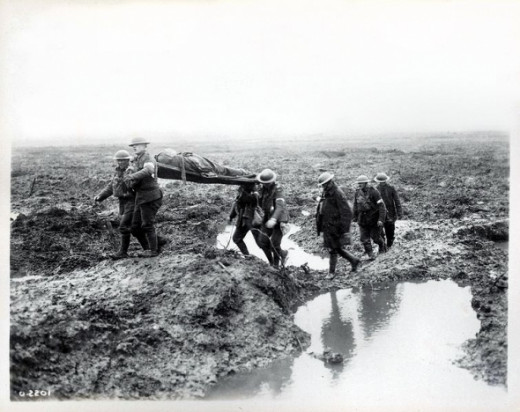The Battle of Passchendaele

The Battle of Passchendaele Begins
On 18 July a preliminary bombardment that lasted ten days was launched against the German troops which constituted the Third Battle of Ypres in West Belgium, Flanders. It was called the Battle of Passchendaele. The bombardment destroyed the drainage systems making flooding of the area more inevitable especially since there had been the heaviest rain in thirty years in the Summer of 1917. When the Infantry launch came on 31 July at 3:50 the already expended four and a quarter million shells meant that tanks got stuck in the mud and infantry mobility was limited. It became known by the soldiers as, 'The Battle of Mud.'
The intro photo of Stretcher bearers Passchendaele August 1917 is a Public Domain image
200,000 were wounded on the Western Front during the Great War

The Battle
General Douglas Haig had launched the attack believing that the German forces were close to collapse since the Battle of the Somme earlier that year but this was not the case. Since the bombardment the element of suprise was lost and the Germans expected an attack. Sir Hubert Gough's Fifth Army opened the attack with Sir Herbert Plumer's Second Army, (one corps) on the right and a corps of the French First Army led by Antoine on the left, making twelve divisions in all. The attack was launched across an 18km front. However, the French were halted north by the German Fifth Army under Galluritz and the Fourth Army led by Arnim restricted the British advance to limited gains in the left line around Pilckem Ridge. 'Bite and Hold' attacks took place in order to wear down the German Army and gain terrain.
War of Attrition
General Plumer had originally when capturing the Messines-Wytschaete Ridge advised continueing the battle onto the Passchendaele Ridge but Haig had disagreed and he chose not to brign his plans forward from the end of July. David Lloyd George the British Primeminister did not want to approve the plans but did so anyway. He was later to call it an example of 'senseless waste and poor generalship'.
Map of the Battle of Passchendaele

The Battle Ending
Indeed, the battle only ended when the Canadian Corps took Passchendaele, five miles from the start of the offensive on 6 November 1917 ending the battle. 5 km of new territiory was gained for 140,000 combat deaths, approx 5cm per dead soldier. It proved to be a hollow victory as the Germans recaptured the lost ground at the Battle of Lys five months later without resistance, but lost it permanently in September 1918.
325,000 British soldiers died and casualties from both sides exceeded 850,000
Passchendaele Photo Gallery
Click thumbnail to view full-size

















